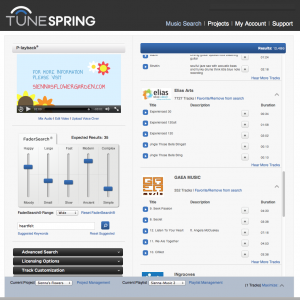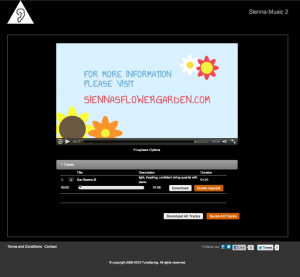TuneSpring Offers New Workflow For Ad Music
As music licensing has become a bread-and-butter revenue stream for so many recording artists, songwriters and composers, a number of licensing companies have emerged in recent years, promising to help rights holders sell their music.
The spectrum of services and solutions ranges from turnkey publishing companies to highly personalized licensing companies like Bank Robber and Zync Music to stock music clearinghouses like Getty’s Pump Audio – and many others (i.e. Jingle Punks, Rumblefish, etc.) in between. But it’s still rare to find a solution that addresses music buyers and sellers like the newly minted TuneSpring.
NYC- and London-based composer Paul Riggio developed TuneSpring specifically – to start – for the advertising industry. As owner and composer of his own ad music house, Riggio is himself the user he saw as TuneSpring’s initial customer. Well, at least one of them.
In a sea of licensing engines, Riggio distinguishes that for music sellers like him, TuneSpring is “the only place that offers an integrated, brandable search and management tool, as well as promotion and marketing through an aggregate website”. But TuneSpring was developed as much with music buyers as sellers in mind – to ease the process of sourcing music for media projects.
A Brief History
Riggio created So Loud Music in 2005 after working as a staff composer at ad-music-stalwart Big Foote. With his own company, he planned to work nimbly on a wide range of projects including cutting-edge advertising, indie films, new and still-experimental media, and even the occasional record. He hired a staff composer and signed a handful of others to write for demos and to represent for licensing opportunities. He pitched and won new business.
But in the time he was establishing So Loud, budgets began to drop across the board – by 2008, some agencies seemed to have half the budget for original music than they’d had for similar projects the previous year.[1]
Exclusive and non-exclusive licensing deals began to eclipse publishing buyouts as the typical transaction for original music, scored to picture – never mind the widespread (and growing) method of licensing tracks directly from artists. These new “norms” were transforming the business. And flexible (lower overhead) music houses like So Loud were embracing that change – offering licensing options on their custom music.
To streamline the music production and pitching process at So Loud, Riggio had developed an internal music library of his and his composers’ catalogs. This way, So Loud could quickly do “a pull” when a request came in – i.e. sounds like Feist but with beats, like Ke$ha. In the process, he developed the core concept that would later spin off into TuneSpring.
It wasn’t that what he’d created internally was particularly unique – many music houses had invested in public-facing libraries by that point, and implemented tools like WireDrive to create dynamic presentations of their music against the clients’ video. But as Creative Director of a small music house dealing with big agencies like BBDO, Ogilvy, McgarryBowen and McCann, Riggio experienced time and again a music-to-picture process he refers to as “complicated and annoying” and only saw cost-prohibitive solutions.
A Library of Libraries
“Imagine a place where buying and selling music for Internet, TV or film use is simple… Making it as easy to find/license that perfect music track as it is to market and sell.”
TuneSpring is a search engine for music buyers and a web application for music sellers. It is both a searchable aggregated music library – located at Tunespring.com – and a customizable search engine, presentation and sales tool for composers, music houses and publishers’ own catalogs.
At the moment, Tunespring.com features nearly 18,000 tracks, including catalogs owned by respected music houses such as Elias Arts, Tone Farmer and Propeller Music, licensing agencies like ARMM, INGroovesFontana and Number 7 Records, and award-winning composers such as Jamie Lawrence and Duke Bojadziev. Meanwhile, TuneSpring – the web application – serves as a user’s entire workflow for sourcing or selling music…stopping short of the sale itself.
To his target advertising audience, Riggio explains: “Right now, the process is such that you would have to make so many calls to so many different music entities to get the same results that you get on TuneSpring. And you’d have to know which entities to call. And how many resources can you possibly know, let alone contact?”
An aggregated “library of libraries”, TuneSpring allows users to cast a wider net searching for that perfect track.
“The concept of one company having every answer, musically and creatively – it’s something everyone strives for but, ultimately, it’s not possible,” Riggio continues. “Music companies have different niches, different personalities, and different ideas about what the ‘right music’ is. That personality, like any personality, will not be for every single person, and will not work on every single project.”
So that the TuneSpring search doesn’t become just as daunting as an analog search, Riggio has implemented parameters for music buyers, including the ability to flag favorites or “hide” certain libraries. This way, like in life, you can curate a short-list as you go, but also be more inclusive of a wider world of options.
And presumably that wider world will be worth your time. The cost of TuneSpring is just enough of a barrier to provide some quality control, but also prove cost-effective when compared with the alternative – proprietary web development plus higher-cost tools like WireDrive.
Both music buyers and sellers pay to use TuneSpring – plans scale by storage size and number of users and “projects”, and start at $19.99/month. But TuneSpring takes no percentage of the music sale. In fact, that’s where the process goes offline. In advertising, producers will most likely need some level of customization done to the track, they may ask for sound design, and then the inevitable revisions. That whole process happens after you’ve made the connection on TuneSpring – the client has found the tracks based on their criteria (licensing availability, customizability, budget, etc.) and the music seller keeps 100 percent of the sale.
Meanwhile, every user gets a customizable version of TuneSpring that can be branded and embedded into their own websites – serving as their company’s library, organizational backend (projects, video elements, track license expirations, metadata) and presentation tool.
And it’s this last functionality that, for many, will be the product’s killer app.
It’s All In The Presentation
TuneSpring can be the turnkey management tool for a music company’s entire pre-negotiation workflow. To demo for an advertising gig, they’ll need to first pitch music they’ve created or selected to fit the creative brief, then synch a shorter list to the client’s rough cut, or wireframes. This process can be very time consuming (and costly), considering they haven’t won the job yet.
“Typically when you send a presentation to a client to review, each track requires its own QuickTime video,” Riggio explains. “So if you’re sending 20 pieces of music, you’re sending 20 QuickTimes for the client to review. This takes a long time to put together, and the logistics of all that can actually de-emphasize the music in the process.”
With TuneSpring’s “P-Layback Video Synch” tool, users can create a presentation with one video and a track playlist that allows their clients to easily demo different tracks against their picture.
“What’s particularly unique is that the synch starts during the actual search process… every time a track is played, video plays at the same time, while you browse music,” says Riggio. “Then, you add the tracks you like to your playlist, and share with clients in synch with your video.
“It’s really easy to focus on the music because the synching process is streamlined. So you get this feel for the picture, and you’re also able to see which tracks you like and make decisions about what you like.”
Similarly on the client side, a producer or creative director can create a “project” to share with their colleagues, uploading video and then selecting a number of tracks to synch. They don’t have to actually start the process of reaching out to a music house until they’ve established that a track works well with the picture.
“You can guess how that piece of music feels, and that’s typically what everybody has to do, but it’s not until they download the track and put it up against picture that they really understand how it feels as part of their project,” Riggio describes.
“This is a tool that I think will really make the lives of music supervisors and music producers much easier and a tool that can empower art directors and creative directors and regular directors – anyone who needs music – bringing all of these great music resources into the same environment, and letting you synch to picture as you search.”
Check out TuneSpring at http://www.tunespring.com via a 15-day free trial. And watch the video tour below.
[1] The author worked for a time as a producer at So Loud.
Please note: When you buy products through links on this page, we may earn an affiliate commission.









